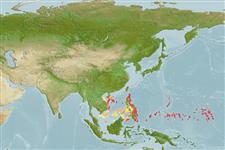>
Eupercaria/misc (Various families in series Eupercaria) >
Labridae (Wrasses)
Etymology: Labropsis: Greek, labrax, -akos = a fish, Dicentrarchus labrax + Greek,opsis = appearance (Ref. 45335).
More on author: Randall.
Environment: milieu / climate zone / depth range / distribution range
Ökologie
seewasser riff-verbunden; tiefenbereich 0 - 33 m (Ref. 37816). Tropical; 21°N - 4°N
Western Central Pacific: Palau, Caroline, Mariana and Marshall Islands.
Size / Gewicht / Alter
Maturity: Lm ? range ? - ? cm
Max length : 12.0 cm TL Männchen/unbestimmt; (Ref. 9710); common length : 9.0 cm SL Männchen/unbestimmt; (Ref. 37816)
Rückenflossenstacheln (insgesamt) : 9; Rückenflossenweichstrahlen (insgesamt) : 12; Afterflossenstacheln: 3; Afterflossenweichstrahlen: 11. Juveniles under 40 mm are black with two broad white stripes (Ref. 1602).
Occurs in clear lagoon and seaward reefs at depths of 7 to over 33 m. Juveniles usually associate with ramose Acropora corals to gain protection from the branches. The species engage in cleaning activities usually with small fishes such as damselfishes. Minimum depth reported taken from Ref. 128797.
Life cycle and mating behavior
Maturities | Fortpflanzung | Spawnings | Egg(s) | Fecundities | Larven
Oviparous, distinct pairing during breeding (Ref. 205).
Randall, J.E., 1981. Revision of the labrid fish genus Labropsis with description of five new species. Micronesica 17(1-2):125-155. (Ref. 2137)
IUCN Rote Liste Status (Ref. 130435)
Bedrohung für Menschen
Harmless
Nutzung durch Menschen
Fischereien: kommerziell; Aquarium: Kommerziell
Tools
Zusatzinformationen
Download XML
Internet Quellen
Estimates based on models
Preferred temperature (Ref.
123201): 27.1 - 28.8, mean 28.4 °C (based on 30 cells).
Phylogenetic diversity index (Ref.
82804): PD
50 = 0.5156 [Uniqueness, from 0.5 = low to 2.0 = high].
Bayesian length-weight: a=0.00955 (0.00456 - 0.02002), b=3.06 (2.89 - 3.23), in cm total length, based on LWR estimates for this (Sub)family-body shape (Ref.
93245).
Trophic level (Ref.
69278): 3.3 ±0.6 se; based on size and trophs of closest relatives
Widerstandsfähigkeit (Ref.
120179): hoch, Verdopplung der Population dauert weniger als 15 Monate. (Preliminary K or Fecundity.).
Fishing Vulnerability (Ref.
59153): Low vulnerability (10 of 100).
Nutrients (Ref.
124155): Calcium = 101 [60, 177] mg/100g; Iron = 0.782 [0.451, 1.449] mg/100g; Protein = 18.5 [15.6, 20.7] %; Omega3 = 0.167 [0.104, 0.269] g/100g; Selenium = 23.2 [13.5, 42.6] μg/100g; VitaminA = 153 [48, 577] μg/100g; Zinc = 1.81 [1.23, 2.83] mg/100g (wet weight);
